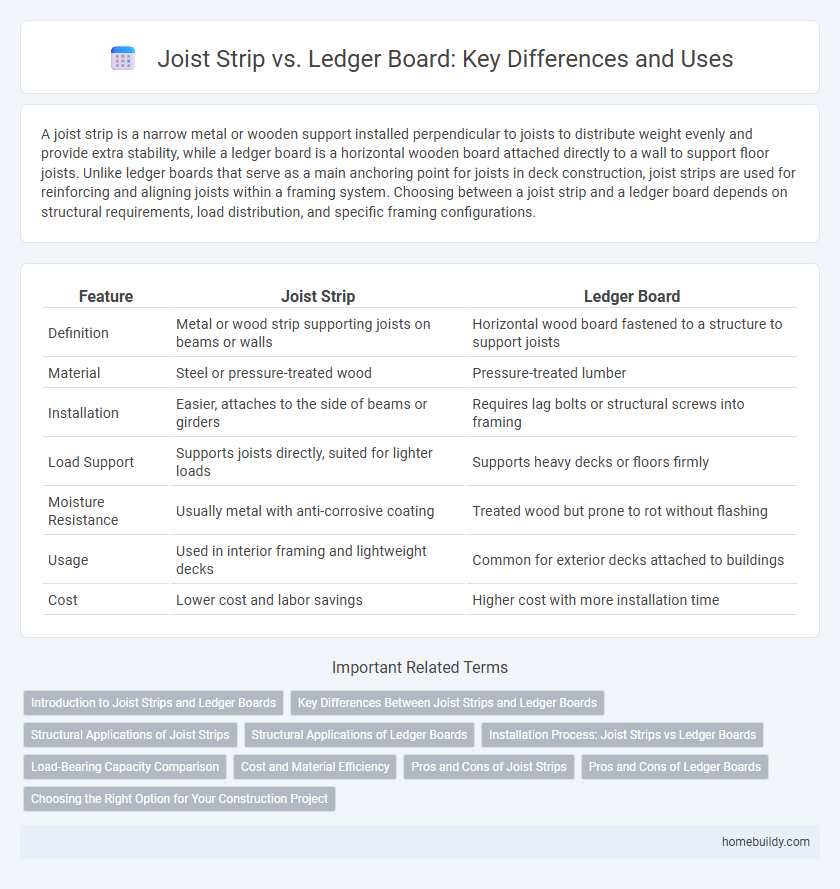A joist strip is a narrow metal or wooden support installed perpendicular to joists to distribute weight evenly and provide extra stability, while a ledger board is a horizontal wooden board attached directly to a wall to support floor joists. Unlike ledger boards that serve as a main anchoring point for joists in deck construction, joist strips are used for reinforcing and aligning joists within a framing system. Choosing between a joist strip and a ledger board depends on structural requirements, load distribution, and specific framing configurations.
Table of Comparison
| Feature | Joist Strip | Ledger Board |
|---|---|---|
| Definition | Metal or wood strip supporting joists on beams or walls | Horizontal wood board fastened to a structure to support joists |
| Material | Steel or pressure-treated wood | Pressure-treated lumber |
| Installation | Easier, attaches to the side of beams or girders | Requires lag bolts or structural screws into framing |
| Load Support | Supports joists directly, suited for lighter loads | Supports heavy decks or floors firmly |
| Moisture Resistance | Usually metal with anti-corrosive coating | Treated wood but prone to rot without flashing |
| Usage | Used in interior framing and lightweight decks | Common for exterior decks attached to buildings |
| Cost | Lower cost and labor savings | Higher cost with more installation time |
Introduction to Joist Strips and Ledger Boards
Joist strips are metal or wood components designed to support and align floor joists, providing a stable framework for flooring systems. Ledger boards are horizontal boards attached to a structure, serving as a mounting point for joists to ensure secure attachment and load distribution. Choosing between joist strips and ledger boards depends on project requirements, structural design, and material compatibility for optimal construction performance.
Key Differences Between Joist Strips and Ledger Boards
Joist strips are narrow metal or wood components used to support and align floor joists, while ledger boards are horizontal boards attached to a structure's main framing to support joists at one end. Joist strips primarily provide lateral stability and prevent joist rotation, whereas ledger boards bear significant structural load and transfer weight to the building frame. The key differences include their load-bearing functions, installation methods, and roles in structural support systems.
Structural Applications of Joist Strips
Joist strips provide critical support in structural applications by evenly distributing loads across floor systems, enhancing stability and preventing sagging. Unlike ledger boards, joist strips secure individual joists directly to the supporting structure, reducing the risk of shifting and increasing overall rigidity. Their use in floor framing ensures precise alignment and a stronger framework, essential for long-term durability in residential and commercial buildings.
Structural Applications of Ledger Boards
Ledger boards provide crucial structural support by securely anchoring floor joists to existing walls, ensuring stability and load distribution in deck construction. Unlike joist strips, ledger boards are designed to carry significant weight and resist lateral forces, making them essential for attaching decks to buildings. Proper installation of ledger boards, including flashing and lag bolts, prevents water infiltration and enhances the overall durability of the structure.
Installation Process: Joist Strips vs Ledger Boards
Joist strips install by attaching directly to a supporting beam or rim joist, creating a ledge to rest floor joists on, often requiring fewer fasteners and less precision in alignment compared to ledger boards. Ledger boards require precise attachment to existing structure using bolts or lag screws, ensuring strong lateral support and load transfer for deck or floor framing. The joist strip installation typically offers a faster setup with minimal structural alteration, while ledger boards involve more rigorous preparation and accurate positioning for long-term stability.
Load-Bearing Capacity Comparison
Joist strips provide a more efficient load-bearing solution compared to ledger boards due to their direct attachment to structural joists, distributing weight evenly across multiple support points. Ledger boards carry loads primarily on the fasteners and the attachment surface to the building frame, which can lead to higher stress concentrations and potential failure if not properly installed. Engineers recommend joist strips for enhanced structural stability in decking and flooring applications where load distribution is critical.
Cost and Material Efficiency
Joist strips offer a more cost-effective solution compared to ledger boards due to their simpler installation process and reduced need for heavy-duty fasteners. Made from lightweight metal or durable composite materials, joist strips minimize material waste and optimize structural support with less bulk. This efficiency makes joist strips ideal for budget-conscious projects requiring reliable load distribution without the higher material costs associated with traditional ledger boards.
Pros and Cons of Joist Strips
Joist strips offer a streamlined and space-saving alternative for securing floor joists to beams, providing easy installation and reducing the need for heavy hardware compared to ledger boards. They improve load distribution along the beam surface but may lack the robust lateral support and adjustment flexibility that ledger boards provide for deck construction. While joist strips minimize beam notching and preserve structural integrity, their limited accessibility for future modifications can be a significant drawback in long-term projects.
Pros and Cons of Ledger Boards
Ledger boards provide strong structural support by securely attaching floor joists to an existing wall, making them ideal for deck construction and extensions. However, they require precise installation and regular maintenance to prevent water damage and rot, which can compromise the building's safety over time. Unlike joist strips, ledger boards demand more labor and expertise, increasing overall project costs and complexity.
Choosing the Right Option for Your Construction Project
Joist strips provide a simpler and more economical solution for securing floor joists to walls without extensive structural modifications. Ledger boards offer superior load-bearing capacity and are ideal for supporting heavy decks or multi-level constructions requiring robust anchoring. Selecting between joist strips and ledger boards depends on project requirements, load specifications, and installation complexity to ensure structural safety and compliance with building codes.
Joist strip vs Ledger board Infographic

 homebuildy.com
homebuildy.com